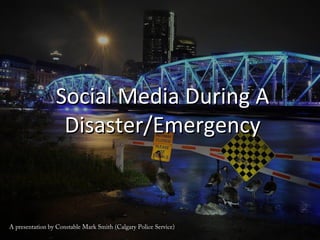
Social Media During a Disaster Webinar version
- 1. Social Media During ASocial Media During A Disaster/EmergencyDisaster/Emergency A presentation by Constable Mark Smith (Calgary Police Service)A presentation by Constable Mark Smith (Calgary Police Service)
- 2. Introduction What is Social Media?What is Social Media?
- 3. Who Uses Social Media?Who Uses Social Media? • 74% of all internet users are now active on social media74% of all internet users are now active on social media • 89% of people between ages of 18-29 use social media89% of people between ages of 18-29 use social media • 82% of the 30-49 age group use social media82% of the 30-49 age group use social media • 65% of people between 50-65 use social media65% of people between 50-65 use social media • 49% of people over 65 years of age use social media49% of people over 65 years of age use social media Based on research conducted (January 2014) by PEW research centerBased on research conducted (January 2014) by PEW research center
- 4. Top Reasons To Utilize Social Media During A Disaster/Emergency • Immediacy • Ability to Inform • Wide Reaching • Two-Way Information Sharing • Rumour Management • Easy Access
- 5. How To Be PreparedHow To Be Prepared • TrainingTraining • EquipmentEquipment • Communication Plan –Communication Plan – Who, Why, HowWho, Why, How • Staff ExperienceStaff Experience
- 6. Information Overload!Information Overload! • Inundated with information • Train up other members of the team • Have good equipment available • Learn how to answer questions quickly
- 7. SM Monitoring ToolsSM Monitoring Tools We use Radian 6, others available Multiple operators Limitations Radian 6 during 2013 floods
- 8. Which Social Media To Use?Which Social Media To Use? Top Sites With Most Active Users:Top Sites With Most Active Users: •TwitterTwitter •FacebookFacebook •RedditReddit •InstagramInstagram •YouTubeYouTube Less Active Sites:Less Active Sites: •MyspaceMyspace •PintrestPintrest •FlickrFlickr
- 9. Benefits/Negatives Of Each Platform. Twitter – Positives: •Immediate information •Insert links •Attach pictures/videos •Respond quickly (rumour control) •Wide reaching Twitter – Negatives: •Limited to 140 characters •Inundated with questions Facebook – Positives: •Unlimited amount of information per post •Attach pictures/videos and web links •Shared by other users •Answer questions in posts (rumour control) Facebook – Negatives: •Time consuming to track questions •Less two-way communication
- 10. First Point Of Contact • You are the first point of contact • Gain management support • Speaks on behalf of the organization • Email lists (Internal & other agencies)
- 11. Twitter Jail Limit of 240 tweets per hour or 2400 tweets per day Can remain locked between 1 to 24 hours Example: 2013 Calgary Flood – Calgary Police Service Twitter account
- 12. What Is A Verified Twitter Account? = Verified Account Ongoing account verification by Twitter Increased tweet cap Able to send direct messages (DM) to all accounts [Spot the difference][Spot the difference]
- 13. Use Of The Period Symbol On Twitter Normal reply = Seen by one user Place (.) before reply = Seen by all followers Tricks twitter Use one question to answer others
- 14. Twitter Lists • Proactively create Twitter lists • Share Twitter list during a disaster • Media can benefit from Twitter lists • Allows us to control rumours • Examples (Calgary Police, City of Calgary, Enmax, CEMA) etc…
- 15. Use Hashtags #Use Hashtags # Start using hashtags earlyStart using hashtags early Easier conversation trackingEasier conversation tracking Keeps community in one placeKeeps community in one place
- 16. Key Points To An Effective Online Disaster Communications Response Develop strategic relationships pre-crisis Listen and respond to the concerns of the public Be honest and transparent Be available and accommodating to the media Communicate with sympathy Provide key messages If you don’t know – Say so
- 17. Release The Keys! Don’t restrict operators Keep social media operators updated (email lists) Utilize two-way interaction If you don’t know the answer, say so Don’t go Code Black! Updates…. Be sensitive and professional
- 18. Utilize Images And Video SharingUtilize Images And Video Sharing
- 19. Utilize Public Tweets & Posts To Help The Response Effort Use available public photos/updates Build a picture of the scene (not 100% reliable) Share with incident commanders Reach out to social media users (don’t be afraid to ask) Rumour control Only RE-TWEET official updates Do share positive stories
- 20. Internal Messaging • Don’t neglect internal organization messaging • External/Internal info should be similar • Increases morale • Internal call out system
- 21. Should Emergency Calls Be Taken Via SocialShould Emergency Calls Be Taken Via Social Media? Things to consider:Things to consider: Lack of informationLack of information Privacy issuesPrivacy issues False reportingFalse reporting Information sharing delaysInformation sharing delays Can SM operator dispatchCan SM operator dispatch
- 22. SM Policy & Procedure Draft up policy for organizationDraft up policy for organization Staff familiarizationStaff familiarization Crisis control proceduresCrisis control procedures
- 23. • Currently not available in Canada • Will notify any Twitter user immediately • Highlighted notification
- 24. Don’t Be Afraid To Say Thanks!Don’t Be Afraid To Say Thanks!